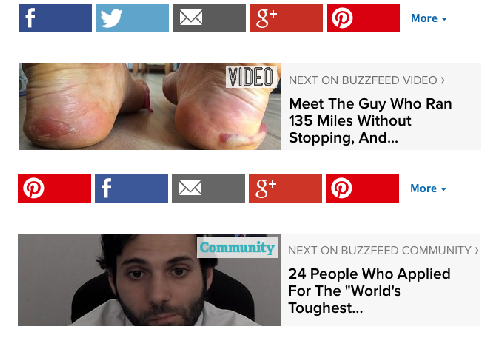There’s an optimization gap in digital publishing. While advertisers are using sophisticated targeting for ads, publishers are usually showing the same content to all readers, no matter who they are or where they came from.
Many, however, are slowly catching up. Publishers like Upworthy, BuzzFeed, and The Washington Post are realizing that success in digital publishing is a game of tiny optimizations. Most readers aren’t visiting sites via their front pages, making it key that publishers tweak reader experiences, headlines, and page layouts in an effort to make their content more palatable and sharable for specific audiences.
BuzzFeed offers a particularly good example. When a reader visits BuzzFeed via Pinterest, the site not only increases the size of the Pinterest “Pin It” button but also removes the Twitter share button entirely. That’s because only 8 percent of users who click BuzzFeed link on Pinterest end up sharing the story via Twitter. BuzzFeed also adds a “hot on Pinterest” module when readers visit the site via Pinterest. The result: Pinterest drives more referrals to BuzzFeed than Twitter.

Upworthy, which also gets most of its traffic through social channels, is also looking at how it can tweak user experience based on whether readers come to the site directly or through other means. The move is a sensible one considering that Upworthy is already well-known for giving its stories at least 25 possible headlines each. Extensive A/B testing is already a part of its core formula.
“We’re doing it in a way that looks at the net effect,” said Ed Urgola, Upworthy’s director of marketing. “Whether it means starting to personalize based on the source or show a new user something different from a returning one, everything is done by considering how it affects that one decision that the reader’s going to make when they’re finished reading a story.”
The Washington Post is also giving the idea a go: When readers visit the site from social networks, they’ll be automatically greeted with “Social Flow”, a social layer shows readers how people on Twitter and Facebook are talking about The Washington Post’s stories. Users who visit the site directly won’t see the feature by default.
This constant testing and tweaking is emblematic of the modern media system, which often seems less about having a grand vision and more about mastering the latest traffic-driving technique. For a time, search optimization was the go-to tactic for publishers. These days, fast-growing publishers tend to have mastered social optimization.
These optimization tactics bleed into the business side, of course. Take the new profusion of content marketing ad networks like Outbrain and Taboola. Many publishers use these in a classic arbitrage game. They will pay 5 cents for a click, then direct users to special landing pages loaded with dozens of ads, with content split into slideshows, that allow it to clear more than 5 cents. This is just how ends meet in a rough ad market. Take a look at this page from Answers.com, arrived at from content marketing network Zergnet. Somehow, “9 celebrity faces destroyed by drugs” has morphed into a 49-part slideshow, with the page gummed up with dozens of ads and an autoplay video spot.
Still, any given tactic can be used for both good and evil. For instance, back when search was the lion’s share of referral traffic for publishers, CNET used to greet search visitors with a “Welcome Google user” message that suggested related content.
Now, publishers are figuring out ways to adapt such tactics for a social era. Both Search Engine Land and travel site Skift, for example, plan to incorporate these sorts of referrer-based reader experiences in future site redesigns. “We’re definitely wanting to evolve so that if we have some idea of who you are, we may present certain elements differently,” said Search Engine Land founding editor Danny Sullivan.
This sort of customization could also help solve the problem that publishers face with chasing social traffic. While Facebook referrals are taking up a larger chunk of publisher traffic, readers that come through Facebook are rarely as engaged as those who come in directly. Direct visitors spend more that four minutes on site; Facebook visitors spend less than half of that time, according to a recent study by the Pew Research Journalism Project, which analyzed user activity across 26 news websites. By tweaking their sites for fly-by social readers, publishers could have a better chance of holding onto them for longer.
“What this means for news organizations is that there needs to be an understanding of the different audiences,” said Amy Mitchell, Director of Journalism Research at the Pew Center. “Not only are people coming in through search less engaged in these ways than people coming in directly, but they’re also not the same people.”
Image via Mkhmarketing
More in Media

From sidelines to spotlight: Esports events are putting creators center stage
Esports events’ embrace of content creators reflects advertisers’ changing priorities across both gaming and the wider culture. In the past, marketers viewed esports as one of the best ways to reach gamers. In 2025, brands are instead prioritizing creators in their outreach to audiences across demographics and interest areas, including gaming.

Condé Nast and Hearst strike Amazon AI licensing deals for Rufus
Condé Nast and Hearst have joined the New York Times in signing a licensing deal with Amazon for its AI-powered shopping assistant Rufus.

Media Briefing: AI payouts may be entering a new era
AI compensation is evolving — and new models, not just publisher demands, are driving the shift beyond flat-fee licensing.






